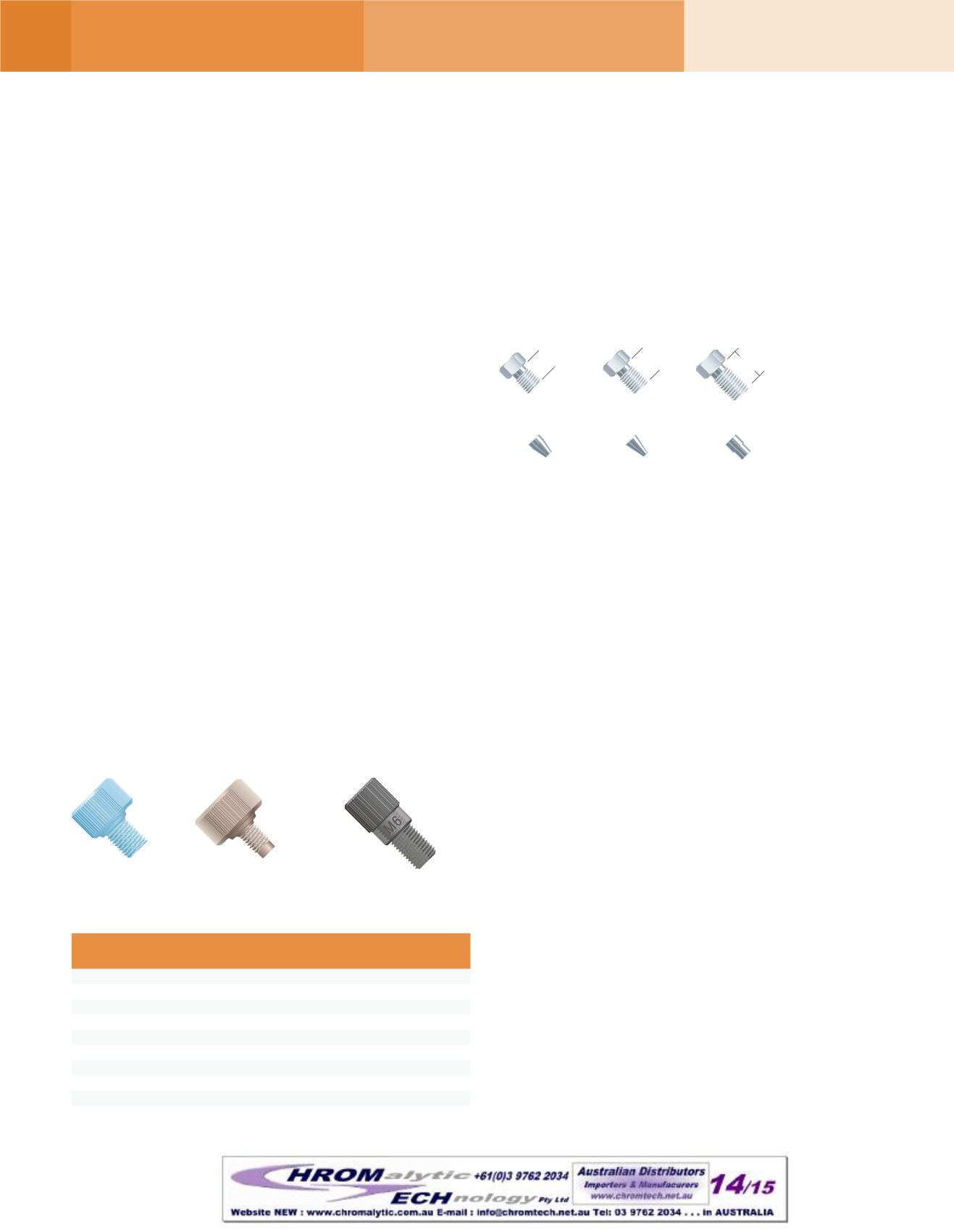
FittingsPrimer
Fittings
Fittings— typically comprisedof anut and ferrule—aredesigned
to connect and seal tubing.While simple in function, fittings canbe
complex indescriptionanduse.General descriptive terms include:
thegeometryof the receivingport (conedorflat-bottom); the tubing
size forwhich thefitting isdesigned; andadescriptionof the threads
on the nut, e.g., 10-32, 1/4-28, etc. Fittingsmay alsobe classified
by dimensions and by the type of material fromwhich they are
manufactured. Additional information— such as tubing andport
material, solvent(s) tobe used, and expected systempressure—
is required to determine which fittings are best suited for a
particular application.
Threads
Several thread sizes are commonly used in analytical fluid transfer.
Themost common sizes are 1/4-28, 10-32, andM6. The first two are
U.S.CustomarySystemmeasurements. The third,M6, ismeasured in
theMetricSystem.
U.S.CustomarySystem
Twonumbersareused todescribea thread
size. Thefirst number indicates thediameter of the threadedportion
of thenut. Threaddiameter numbers range fromgauge1 (0.073”) to
gauge12 (0.216”). Beyond0.216” the threaddiameter isgivenas the
actual diameter in fractionsof an inch. The secondnumber indicates
the threads-per-inch count. Thus, a 1/4-28 nut (Figure 1) has a 1/4”
(0.250”)diameter threadbarreland28 threads-per-inch.A10-32male
nut (Figure 2) has agauge 10 (0.190”) threadbarrel with 32 threads-
per-inch.
MetricSystem
TheMetricSystemalsousesa twonumber system to
describe the threads. Thefirst number, precededby the letterM (for
metric), indicatesthediameterofthethreads inmillimeters.Thesecond
number indicateshowmanymillimetersbetweeneach thread.When
thespacingbetween threads is1mm, thecallout for the threadoften
excludes that secondnumber.Thus,anM6x1 thread isoftendenoted
bya simpleM6 (Figure3).
Pleaseseethepreviouspageforavisualcomparisonofcommonthreads.
Stainless Steel Fittings
Althoughrestrictive inuseandapplication (seetheFittingsApplications
table, bottom left), stainless steel fittings remainpopular formany
analytical applications due to their chemical inertness and high
pressure-holdingcapabilities.
Thedimensions and shapesof stainless steel fittings varyand canbe
manufacturer specific (Figures4and5).Evenso, themost commonly-
usedstainlesssteelfittings forchromatographyemploy10-32 threads,
allowingmany stainless steel fittings tobe pairedwith a variety of
receivingportsprior tobeing swagedontoa tube.
Tobeusedproperlystainlesssteelfittingsmustbeswaged(permanently
attached) to the tubing they are connecting. To do this correctly,
IDEXHealth&Science recommends the followingprocedure:
Place thenutand ferrule, in thatorder,on the tubing.Place this loose
assembly into amatingport and tighten the nut finger tight, while
ensuring the tubing is bottomed out inside the port. Nowwrench
tighten thenutanadditional3/4 turn.
PleaseNote:
The ferrule isnow
permanentlyattachedtothetubingandshouldonlybeused intheport
intowhich itwas swaged. Attempting touseapre-swaged ferrule in
a receivingport that isdifferent from theone intowhich itwas initially
swagedmay result indeadvolumeor leaks (see the Interchangeability
section, next page).
Toproperly tightenapre-swaged stainless steel fitting, IDEXHealth&
Science recommendswrench tighteningonlyanadditional 1/4 to1/2
turnpastfingertight.Shouldany leakingoccur,continuetighteningthe
fittinga littleat a timeuntil the leak stops. If thefitting requiresmore
thanone complete revolutionpast finger tight, we recommend it be
replaced,asexcessivetighteningtypically indicatesadamagedproduct.
Polymer-BasedFittings
Unlike their stainless steel counterparts, polymer fittings are nearly
universal in application (see the Fittings Applications table) and
are comparatively easy touse. Polymer fittings donot permanently
attach to tubing, and they usually do not require any tool (besides
your fingers!) toproperly tighten. Additionally, thesefittings come in
a varietyof polymers, providing several cost, pressureand chemical-
resistanceoptions.
Figure 4
0.210”
(0.533cm)
0.250”
(0.635cm)
0.320”
(0.813cm)
Figure 5
Figure 2
10-32Nut
Figure 1
1/4-28Nut
Figure 3
M6Nut
MATERIALSTRUCTURALCOMPATIBILITY
Fitting
Tubing
Port
Recommended?
Plastic
Plastic
Plastic
Yes
Plastic
Steel
Plastic
Yes
Plastic
Steel
Steel
Yes
Plastic
Plastic
Steel
Yes
Steel
Steel
Steel
Yes
Steel
Plastic
Steel
Sometimes
Steel
Plastic
Plastic
No
Steel
Steel
Plastic
No
184
TECHNICALRESOURCES
Fittings Primer


